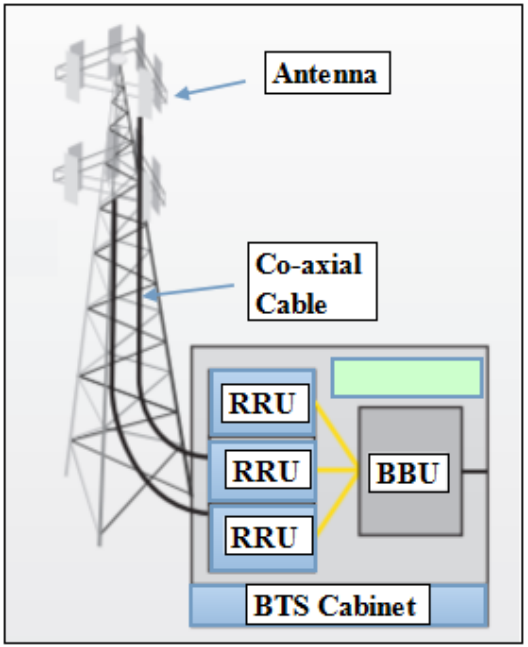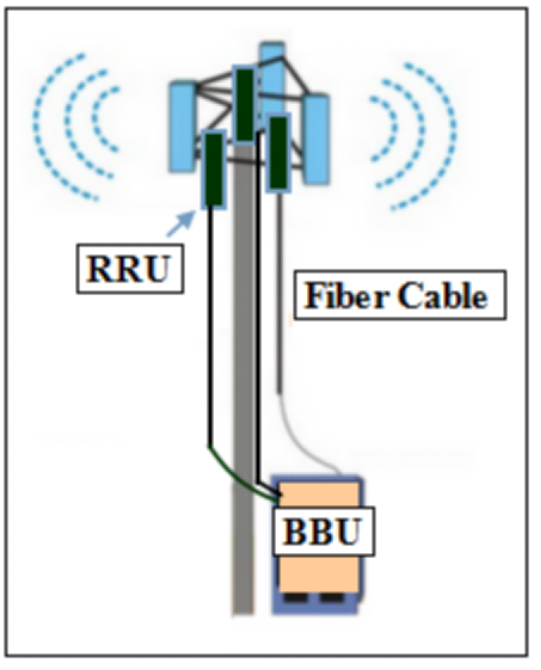CPRI – A High Speed Link
CPRI – Common Personal Radio Interface
Today’s wireless operators face competitive pressure to reduce the rising cost of base stations, to provide higher bandwidth and for better quality of service.
Traditional coaxial-based systems on cell towers or legacy cell towers around the world are being completely overhauled. Bulky, expensive and power-hungry copper cabling is being ripped out and replaced by fiber for more capacity and longer-reach distances.
Traditional Base Station Architecture
In traditional architecture, radio unit and base-band unit are in one single cabinet, so we need to run longer co-axial copper cables from tower base where BTS cabinet is kept to the top of the tower where antennas are installed. Unfortunately, this type of infrastructure is quite restrictive, operators are required to have a large footprint with a dedicated hut, power supply and backup (UPS), and air conditioning facilities. Co-axial Copper cabling is also quite restrictive due to the inherent power-hungry amplifiers, appropriate cooling, and battery backups to make sure everything is running according to specifications. As a result, the cost to run a cell site becomes prohibitive as there is more and more need to build and maintain even more cell sites to satisfy the expected mobile user demand. While the current legacy cell towers do work, they are not ready for what the future holds for mobile device users. Moreover, they will not be cost-efficient down the road.
These shortcomings in traditional architecture causes shift to a fiber-optic infrastructure now which offers more scalability that will help guarantee coverage and bandwidth growth as well as cost efficiency for years to come.
Modern Base Station Architecture
The communication protocol running over the fiber between the baseband unit (BBU) and the remote radio unit (RRU) is the Common Public Radio Interface (CPRI). It was established in 2003 by base station vendors, such as Ericsson, Nokia Siemens Networks, Alcatel Lucent, NEC, and Huawei Technologies, to define a publicly available specification that standardizes the protocol interface between base station devices (baseband unit and remote radio unit.)
Benefits
- Efficient network deployment
- Efficient product differentiation with faster time to market
- It offers high speed link, higher bandwidth and so multiple RRU can be connected with single BBU
- Concept of C-RAN (Centralized Radio Access Network ) is possible as common BBU can be placed far away from radio unit and multiple radio units can be connected with single BBU.
Line Bit Rate
In order to achieve the required flexibility and cost efficiency, several different line bit rates are defined. Therefore, the CPRI line bit rate may be selected from the following option list:
CPRI line bit rate option 1: 614.4 Mbit/s
CPRI line bit rate option 2: 1228.8 Mbit/s
CPRI line bit rate option 3: 2457.6 Mbit/s
CPRI line bit rate option 4: 3072.0 Mbit/s,
CPRI line bit rate option 5: 4915.2 Mbit/s
CPRI line bit rate option 6: 6144.0 Mbit/s
CPRI line bit rate option 7: 9830.4 Mbit/s
CPRI line bit rate option 7A: 8110.08 Mbit/s
CPRI line bit rate option 8: 10137.6 Mbit/s
CPRI line bit rate option 9: 12165.12 Mbit/s
It is mandatory that each BBU and RRU support at least one of the above cited line bit rates.
Hardware Required
CPRI data communication is done using small form-factor pluggable (SFP) transceiver.
Example: Flyin Optronics’ 6.25G CPRI/OBSAI SFP Transceiver FPP-xx7-xxx(D) is designed to transmit and receive optical data over Single-mode Fiber and Multi-mode Fiber, applied in serial data communications such as CPRI and OBSAI. Multi Rate up to 6.25Gbps, transmission distance 300m to 80km.
The CPRI standard offers today’s wireless network equipment manufacturers with a standardized internal digital serial interface that provides both simplicity and flexibility. More importantly, it contributes to the reduction of base station infrastructure costs.







